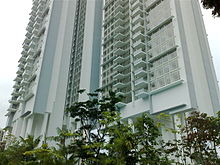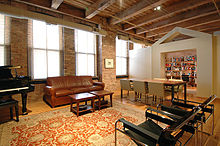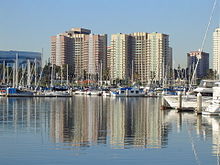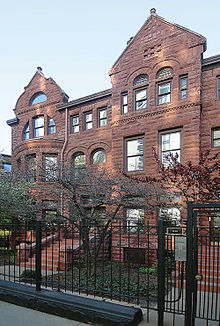- Condominium
-
This article is about the form of housing. For the international law describing a territory in which two sovereign powers have equal rights, see Condominium (international law).
A condominium, or condo, is the form of housing tenure and other real property where a specified part of a piece of real estate (usually of an apartment house) is individually owned while use of and access to common facilities in the piece such as hallways, heating system, elevators, exterior areas is executed under legal rights associated with the individual ownership and controlled by the association of owners that jointly represent ownership of the whole piece.
Colloquially, the term is often used to refer to the unit itself in place of the word "apartment". A condominium may be simply defined as an "apartment" that the resident "owns" as opposed to rents.
Condominium is the legal term used in the United States and in most provinces of Canada. In Australia and the Canadian province of British Columbia it is referred to as strata title. In Quebec the term "divided co-property" (French: co-propriété divisée) is used, although the colloquial name remains 'condominium'. In France the equivalent is called copropriété (co-ownership), usually managed by the syndic. In New Zealand an "apartment" refers to a unit that is owned, while a rented unit is referred to as a "flat". In South Africa, this form of ownership is called Sectional Title, with the owners constituting the Body Corporate.[1]
Contents
Overview
The difference between a condominium and an apartment complex is purely legal: there is no way to know a condominium from an apartment simply by looking at or visiting the building. What defines a condominium is the form of ownership. The same building developed as a condominium (and sold in individual units to different owners) could actually be built someplace else as an apartment building (the developers would retain ownership and rent individual units to different tenants). As a practical matter, though, builders tend to build condominiums to higher quality standards than apartment complexes because of the differences between the rental and sale markets.
Technically, a condominium is a collection of individual home units and common areas along with the land upon which they sit. Individual home ownership within a condominium is construed as ownership of only the air space confining the boundaries of the home (Anglo-Saxon law systems; different elsewhere). The boundaries of that space are specified by a legal document known as a Declaration, filed of record with the local governing authority. Typically these boundaries will include the drywall surrounding a room, allowing the homeowner to make some interior modifications without impacting the common area. Anything outside this boundary is held in an undivided ownership interest by a corporation established at the time of the condominium’s creation. The corporation holds this property in trust on behalf of the homeowners as a group–-it may not have ownership itself.
Condominiums have conditions, covenants, and restrictions, and often additional rules, that govern how the individual unit owners are to share the space.
It is also possible for a condominium to consist of single family dwellings: so-called "detached condominiums" where homeowners do not maintain the exteriors of the dwellings, yards, etc. or "site condominiums" where the owner has more control and possible ownership (as in a "whole lot" or "lot line" condominium) over the exterior appearance. These structures are preferred by some planned neighborhoods and gated communities.
A homeowners association (HOA), whose members are the unit owners, manages the condominium through a board of directors elected by the membership. The concept exists under various names depending on the jurisdiction, such as "unit title", "sectional title", "commonhold," "strata council," or "tenant-owner's association", "body corporate", "Owners Corporation", "condominium corporation" or "condominium association." Another variation of this concept is the "time share" although not all time shares are condominiums, and not all time shares involve actual ownership of (i.e., deeded title to) real property. Condominiums may be found in both civil law and common law legal systems as it is purely a creation of statute. Among other things, the HOA assesses unit owners for the costs of maintaining the common areas, etc. That is, the HOA decides how much each owner should pay and has the legal power to collect that.
The description of the condominium units and the common areas and any restrictions on their use is established in a document commonly called a "Master Deed" (also known as the "Enabling Declaration", the "Declaration of Conditions", or the "Condominium Document"). Among other things, this document provides for the creation of the HOA. Rules of governance for the association are usually covered under a separate set of bylaws which generally govern the internal affairs of the condominium. Condominium bylaws usually establish the responsibilities of the owners' association; the voting procedures to be used at association meetings; the qualifications, powers, and duties of the board of directors; the powers and duties of the officers; and the obligations of the owners with regard to assessments, maintenance, and use of the units and common areas. Finally, a set of rules and regulations providing specific details of restrictions on conduct of unit owners and residents are established by the HOA. [2] These are more readily amendable than the declaration or association bylaws, typically requiring only a vote of the HOA board. Typical rules include mandatory maintenance fees (perhaps collected monthly), pet restrictions, and color/design choices visible from the exterior of the units. Generally, these sets of rules and regulations are made available to residents and or as a matter of public record via a condominium or homeowners association website or through public files, depending on the state and its applicable laws. Condominiums are usually owned in fee simple title, but can be owned in ways that other real estate can be owned, such as title held in trust. In some jurisdictions, such as Ontario, Canada or Hawaii USA, there are "leasehold condominiums" where the development is built on leased land.
In general, condominium unit owners can rent their home to tenants, similar to renting out other real estate, although leasing rights may be subject to conditions or restrictions set forth in the declaration (such as a rental cap for the total number of units in a community that can be leased at one time) or otherwise as permitted by local law.
Non-residential uses
Condominium ownership is also used, albeit less frequently, for non-residential land uses: offices, hotel rooms, retail shops, group housing facilities (retirement homes or dormitories), and storage. The legal structure is the same, and many of the benefits are similar; for instance, a nonprofit corporation may face a lower tax liability in an office condominium than in an office rented from a taxable, for-profit company. However, the frequent turnover of commercial land uses in particular can make the inflexibility of condominium arrangements problematic.
Similar Concepts
There are many forms of real estate ownership that are similar to condominiums but not identical.
Classic privately owned detached houses on privately owned lots may be part of a community that has a homeowner's association. Such an association may administer a common park area, for example, or an access road, or architectural standards for the houses.
In a townhouse complex, multiple physical houses are combined into a single architectural building. Each unit owner owns an identified plot of land and the building affixed to it, but that building is physically part of a larger building that spans lots. There is a continuous roof and foundation and a single wall divides adjacent townhouses. Legally, this is very similar to detached houses, but because of the intertwining of interests in the single architectural building, a homeowner's association is required. It would be impractical, for example to replace the roof of just one townhouse. But unlike the condominium, the townhouse complex's HOA owns none of the building or the land under it. It is essentially under contract to the townhouse owners to maintain the parts of the building that are hard to divide. Even the walls between townhouses are usually outside the purview of the HOA, being jointly owned and maintained by the owners of the townhouses on either side. Like the condominium, the townhouse complex often has common areas for roads, parking, clubhouses, and such.
A rowhouse is like a townhouse except that the houses are not physically connected. They are independent structures that simply have no space between them. Technically, they are detached.
A building with multiple residential units may simply be owned in common by multiple people, with each having specific rights to a particular unit and undivided interest in the rest. This is like a condominium, but there is no HOA with legal powers. It is much harder to govern, as the individual unit owners often have to agree unanimously or court intervention is required.
California statutes recognize three kinds of "common interest developments": condominium, townhouse, and community apartment, with the latter being the owned-in-common concept described above.
By jurisdiction
Australia
In Australia, condominiums are known as "community title schemes".[3]
Canada
Condominiums exist in most parts of Canada though more common in larger cities. They are regulated under provincial or territorial legislation and specific legal details vary from jurisdiction to jurisdiction. In most parts of Canada, they are referred to as Condominiums, except in British Columbia where they are referred to as a strata and in Quebec where they are referred to as syndicates of co-ownership.[4] A townhouse complex called Brentwood Village in Edmonton, Alberta was the first condominium development in Canada (registered in 1967; the first high-rise condominium development was Horizon House built by Minto in Nepean, Ontario and registered in 1967.[5]
With regular condominiums, the unit owner usually owns the internal unit space and a share of the corporation; the corporation owns the exterior of the building land and common area; in the case of a freehold condominium the owner owns the land and building and the corporation owns common shared roadways and amenities.[4] The Canadian Condominium Institute is a non-profit association of condominium owners and corporations with chapters in each province and territory.[4]
Ontario
In Ontario, condominiums are governed by the Condominium Act, 1998[6] with each development establishing a corporation to deal with day-to-day functions (maintenance, repairs, etc.). A board of directors is elected by the owners of units (or, in the case of a common elements condominium corporation, the owners of the common interest in the common elements) in the development on at least a yearly basis. A general meeting is held annually to deal with board elections and the appointment of an auditor (or waiving of audit). Other matters can also be dealt with at the Annual General Meeting, but special meetings of the owners can be called by the board and, in some cases, by the owners themselves, at any time.
In recent years, the condominium industry has been booming in Canada, with dozens of new towers being erected each year. Toronto is the centre of this boom, with 17,000 new units being sold in 2005, more than double second place Miami's 7,500 units.[2] Outside of Toronto, the most common forms of condominium have been townhomes rather than highrises, although that trend may be altered as limitations are placed on "Greenfields" (see Greenfield land) developments in those areas (in turn, forcing developers to expand upward rather than outward and to consider more condominium conversions instead of new housing). Particular growth areas are in Kitchener/Waterloo, Barrie, and London. In fact, after Toronto, the Golden Horseshoe Chapter of the Canadian Condominium Institute is one of that organization's most thriving chapters.[3]
The Ontario Condominium Act, 1998 provides an effectively wide range of development options, including Standard, Phased, Vacant Land, Common Element and Leasehold condominiums. Certain existing condominiums can amalgamate, and existing properties can be converted to condominium (provided municipal requirements for the same are met). Accordingly, the expanded and expanding use of the condominium concept is permitting developers and municipalities to consider newer and more interesting forms of development to meet social needs.[citation needed]
On this issue, Ontario condominium lawyer Michael Clifton writes, "Condominium development has steadily increased in Ontario for several years. While condominiums typically represent attractive lifestyle and home-ownership alternatives for buyers, they also, importantly, introduce a new approach to community planning for home builders and municipal approval authorities in Ontario. …[There are] opportunities for developers to be both creative and profitable in building, and municipalities more flexible and imaginative in planning and approving, developments that will become sustainable communities."[7]
Contrary to other jurisdictions such as Alberta, Ontario does not provide flexibility for small condo corporations to conduct their own reserve fund study, or to update it less frequently than required for large corporations. Managers of small condominium corporations have asked the Ontario Ministry of Consumer Services to review this requirement as it becomes burdensome for the management of smaller buildings, by contacting: http://www.sse.gov.on.ca/mcs/Pages/AskAQuestion.aspx
Saskatchewan
In Saskatchewan, condominiums are registered as a special type of non-profit corporation that is owned by the unit owners; the owners elect a board of directors; the operation of the corporation is governed by The Condominium Property Act.[8]
Denmark
Apartments (Danish ejerlejlighed, literally "owner-apartment") comprise some 5% of Danish homes.[9] They are traded and mortgaged on the same markets as free-standing houses, and are treated legally much like other forms of real estate. Each owner-tenant directly owns his own apartment; the rest of the building and the ground on which it stands is owned jointly by the apartment owners who execute their joint ownership through an owner's association. The expenses of maintaining the joint property is shared pro rata among the owners.
Another 5% of Danish homes are in housing cooperatives (Danish andelsbolig), which occupy a legal position intermediate between condominiums and housing associations. The entire property is legally owned by a non-profit corporation in which the tenants own shares; each share carries the right and duty to lease an apartment from the cooperative. Shares can be bought and sold, but often the cooperative's rules strictly limit the price for which they may change hand. (In contrast, condominiums are traded on a free market). Because the official share prices are often lower than the market value and sellers often retain freedom to select whom to sell to, under-the-table payments are common.[9]
Current public policy favors condominiums over housing cooperatives, and recent legislation have aimed ad making the latter more condominium-like. For example, since 2005, cooperative shares may be used to secure bank loans. (However, Danish mortgage banks still may not mortgage individual housing cooperative apartments).
England and Wales
In England and Wales, the equivalent of condominium is commonhold, a form of ownership introduced in September 2004. As of 3 June 2009, there were 12 commonhold residential developments comprising 97 units in England and one commonhold residential development, comprising 30 units, in Wales.[10]
Hungary
Condominiums (Hungarian:társasházi öröklakás) were formally introduced in 1924. Condominiums are traded and mortgaged on the same markets as free standing houses, and treated much like other forms of real estates.
India
Condominiums are more commonly known as "flats" in India, also referred as apartments sometimes. This type of housing is very common in larger cities like Delhi, Mumbai (Bombay), Chennai (Madras), Kolkata (Calcutta), Bengaluru (Bangalore) and Hyderabad, but are not commonly found in rural areas.
In India, in some of the States they are registered as "co-operative housing society" rather than condominiums in that the owners actually have a share of the co-op and not the actual real estate itself. In such cases, the Owners can sell the "share" in the open market, but they must receive approval from the co-op to complete the transaction. Formation of a Co op Society is not essential for a Condominium. There is no bar for construction of Condominium by private parties. As a matter of fact, apart from a Housing Board under the Government, there is no restriction in making condominium other than some building regulations. Many of the Apartment Ownership Acts apply only to property, the sole owner or all of the owners which submit the same to the provisions of the Acts by duly executing and registering a declaration by which property is to be submitted to the provisions of the Act.
(a) for instance as per Sec.5 (2) of the Kerala Act (Act 5 of 1984) each apartment owner has to execute a declaration that he submits his apartment to the provisions of this Act. The contents of the declaration is specified in Sec.11 of the said Act. The contents of the deeds of apartment is also specified in Sec.12 of the said Act.
Norway
Condominiums (Norwegian Eierseksjon) was formally introduced in 1983. Some 19% of Norwegian homes are condominiums, as approximately 50% of the owner-occupied flats and duplexes, approximately 30% of the rowhouses and 2.5% of the detached houses are organised as condominiums.
Singapore
In Singapore, "Condo" or "Condominium" are terms used for housing buildings with some special luxury features like security guards, swimming pools or tennis courts.
Most housings without such features are built by the governmental Housing Development Board (HDB), and such HDB units can be possessed for rent or individually bought from the government. Condominiums and HDB flats make up the overwhelming majority of available residential housing in the country.
Sweden
On 1 May 2009, condominiums (ägarlägenheter) became available for the first time under Swedish law.[11] Of the 14,447 newly built apartments completed in 2009, only six were condominiums. A majority of production, 7,723 units, were apartments in housing cooperatives (bostadsrättslägenheter), the traditional form of owner occupied apartment housing.[12]
United States
The first condominium law passed in the United States was in the Commonwealth of Puerto Rico in 1958.[13] English Common law tradition holds that real property ownership must involve land, whereas the French civil law tradition recognized condominium ownership as early as the 1804 Napoleonic Code; thus, it is notable that condominiums evolved in the United States via a Caribbean government with a hybrid common-civil legal system. In 1960, the first condominium in the Continental United States was built in Salt Lake City, Utah.[citation needed] Initially designed as a housing cooperative (Co-op), the Utah Condominium Act of 1960 made it possible for "Graystone Manor" (2730 S 1200 East) to be built as a condominium. The legal counsel for the project, Keith B. Romney is also credited with authoring the Utah Condominium act of 1960. Romney also played an advisory role in the creation of condominium legislation with every other legislature in the U.S. BusinessWeek hailed Romney as the "Father of Condominiums".[citation needed] He soon after formed a partnership with Don W. Pihl called "Keith Romney Associates", which was widely recognized throughout the 1970s as America's preeminent condominium consulting firm.[14]
Although often mistakenly credited with coining the term "condominium", Romney has always been quick to point out that it harks back to Roman times, and that he merely borrowed it.[citation needed]
Nowadays, the leadership of the industry is dominated by Community Associations Institute or CAI.[citation needed]
Section 234 of the 1961 National Housing Act allowed the Federal Housing Administration to insure mortgages on condominiums, leading to a vast increase in the funds available for condominiums, and to condominium laws in every state by 1969. Many Americans' first widespread awareness of condominium life came not from its largest cities but from south Florida, where developers had imported the condominium concept from Puerto Rico and used it to sell thousands of inexpensive homes to retirees arriving flush with cash from the urban Northern U.S.[citation needed]
The primary attraction to this type of ownership is the ability to obtain affordable housing in a highly desirable area that typically is beyond economic reach. Additionally, such properties benefit from having restrictions that maintain and enhance value, providing control over blight that plagues some neighborhoods. Major American cities, including Miami, San Francisco, Chicago, New York City, Los Angeles, and Washington D.C., have abundant condominium development.
In recent years, the residential condominium industry has been booming in all of the major metropolitan areas such as Miami, San Francisco, Seattle, Boston, and New York City. It is now in a slowdown phase.[15] According to Richard Swerdlow, CEO of Condo.com, "You're not going to see this giant overbuild again. It's hard to imagine that you'd see in the next decade what we just saw. Real estate brokers and the developers were in almost a ticket-collecting mode. They were processing orders because there was so much business to go around. Now that sort of investor phenomenon has gone away." He added, "That phenomenon has stopped."
An alternative form of ownership, popular in the United States but found also in other common law jurisdictions, is the "cooperative" corporation, also known as "company share" or "co-op", in which the building has an associated legal company and ownership of shares gives the right to a lease for residence of a unit. Another form is leasehold or ground rent in which a single landlord retains ownership of the land on which the building is constructed in which the lease renews in perpetuity or over a very long term such as in a civil law emphyteutic lease. Another form of civil law joint property ownership is undivided co-ownership where the owners own a percentage of the entire property but have exclusive possession of a specific part of the property and joint possession of other parts of the property; distinguished from joint tenancy with right of survivorship or a tenancy in common of common law.
In the United States, there are several different styles of Condominium complexes.
Garden Condominium complex consists of low-rise buildings built with landscaped grounds surrounding them. Townhouse Condominium complex consists of multi-floor semi-detached homes. In condominium townhouses, the purchaser owns only the interior, while the building itself is owned by a condominium corporation. The corporation is jointly owned by all the owners, and charges them fees for general maintenance and major repairs. Freehold townhouses are exclusively owned, without any condominium aspects. In the United States this type of ownership called fee simple.
See also
- Car condo
- Condo conversion
- Condop
- Dockominium, a water-based version
- Housing cooperative
- Canadian Condominium Institute
- Community Associations Institute
References
- ^ [1]
- ^ "Understanding the Government of a Community Association". Kaman & Cusimano. http://www.ohiocondolaw.com/articles/governance_community_assn.htm. Retrieved 24 July 2011.
- ^ "Community title schemes". ACT Planning and Land Authority. ACT Planning and Land Authority’s (ACTPLA) website. http://www.actpla.act.gov.au/topics/design_build/begin_project/community_titles.
- ^ a b c "Condominium Buyers Guide ISBN 0-662-33517-1". Canadian Mortgage and Housing Corporation]. http://www.cmhc-schl.gc.ca/odpub/pdf/63100.pdf. Retrieved 2011-02-26.
- ^ "Highrise condo a Canadian first". Ottawa Sun Sun Media. http://www.ottawasun.com/news/ottawa/2009/08/10/10419716.html. Retrieved 2011-02-26.
- ^ "Condominium Act, 1998, S.O. 1998, c. 19". Queen's Printer for Ontario. Version in force as of access date. http://www.canlii.org/en/on/laws/stat/so-1998-c-19/latest/so-1998-c-19.html. Retrieved 2009-10-06.
- ^ In, A Comment about Condominiums, Community Planning and Sustainability, Forum Magazine, Dec 06/Jan 07, p. 28.
- ^ "The Condominium Property Act, 1993 being Chapter C-26.1* of the Statutes of Saskatchewan, 1993". Queen's Printer. http://www.qp.gov.sk.ca/documents/English/Statutes/Statutes/C26-1.pdf. Retrieved 2011-02-26.
- ^ a b Statens Byggeforskningsinstitut og Amternes og Kommunernes Forskningsinstitut. "Det danske boligmarked - udvikling i boligforsyning og boligønsker" (pdf). http://www.sbi.dk/download/pdf/det_danske_boligmarked.pdf. Retrieved 2009-10-12.
- ^ House of Commons of the United Kingdom, Michael Wills Written Questions, 9 June 2009 col. 792W Commonhold
- ^ Landes, David (11 November 2008). "Owner-occupied flats coming to Sweden". The Local. http://www.thelocal.se/15600/20081111/.
- ^ "Få ägarlägenheter i nyproduktion, korrigerad 2010-10-26" (in Swedish) (Press release). Statistiska Centralbyrån. 6 May 2010. http://www.scb.se/Pages/PressRelease____292864.aspx.
- ^ Poliakoff, G: Law of Condominium Operations, §1.2. 2009.
- ^ Condominium Development Guide (published by Warren, Gorham & Lamont)
- ^ "Reality Check: US Home Resales Firm Feb Vs Jan, Drop y/y". iMarketNews. http://imarketnews.com/?q=node/27899.
External links
Categories:- Condominiums
Wikimedia Foundation. 2010.






